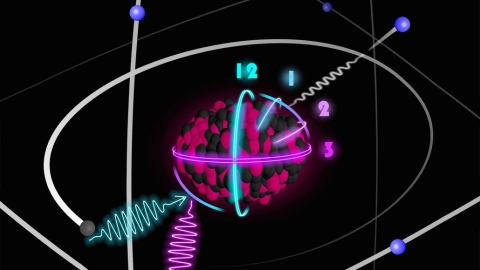March 2023 - May 2023
B anomalies: hopes, disillusions, and future prospects.
Within the Standard Model (SM) the basic constituents of matter are the three "families" (two quarks and two leptons) with different quantum numbers, that completely determine the properties of these particles under the three fundamental forces…
Read moreA word from the Deputy Head of the EP department - March 2023
Dear Colleagues, dear Members of the EP Department and CERN Users, It’s my pleasure to invite you to the reading of the spring edition of the EP Newsletter. The way this fantastic wealth of results and achievement is springing forth really…
Read moreThe Higgs boson and the prospects for elementary particle physics
Particle physics has expanded its scope to include a wide range of topics from very low to very high energies. Its core questions, though, remain the same: to identify the fundamental interactions that govern the universe, and to demonstrate that…
Read moreNew ATLAS result weighs in on the W boson
For the past 40 years, the W boson has been making headlines. In the 1980s, the announcement of its discovery helped confirm the theory of the electroweak interaction – a unified description of electromagnetic and weak forces. Today, measurements of…
Read moreLHCb’s unique approach to real-time data processing
The LHCb collaboration is currently enhancing its unique system of data filtering, Real Time Analysis, by installing a 2nd set of Graphics Processing Units (GPUs) in the trigger system. Current technology does not allow all LHC proton-proton…
Read moreUpgrading the CMS Electromagnetic Calorimeter Readout Electronics for Phase-2
The CMS electromagnetic calorimeter (ECAL) was designed to provide excellent energy resolution for electrons and photons in the challenging, high-radiation environment of the Large Hadron Collider [1]. In particular, the excellent design energy…
Read moreThe IRRAD Proton Facility Journey to get new detector systems ready for the Long Shutdown 3
The proton irradiation facility (IRRAD) at the PS East Area was built during the LS1 to cope with the increasing needs for radiation tests of the experimental community working for the HL upgrade of the LHC and beyond. The IRRAD facility, operated…
Read moreCERN team maps the sPHENIX Solenoid at BNL
In November 2022 the magnet service team of the Detector Technology group performed the mapping of the superconducting solenoid in the sPHENIX experiment at BNL (US). The two-week long campaign was the culmination of preparations that started during…
Read moreChronicles of SND@LHC’s first year of data taking
The year 2022 saw the culmination of 18 months of intense preparatory work with the SND@LHC Collaboration entering the highly anticipated phase of commissioning with beam and first year of data taking. After the installation of the neutron shield…
Read moreRadioactive ion beams at ISOLDE bring the nuclear clock a tick closer
The precise measurement of time and frequencies has always played an important role in the history of science. Since the adoption of the caesium-133 standard as the definition of the second within the Système International (SI) in 1967, a network of…
Read more








